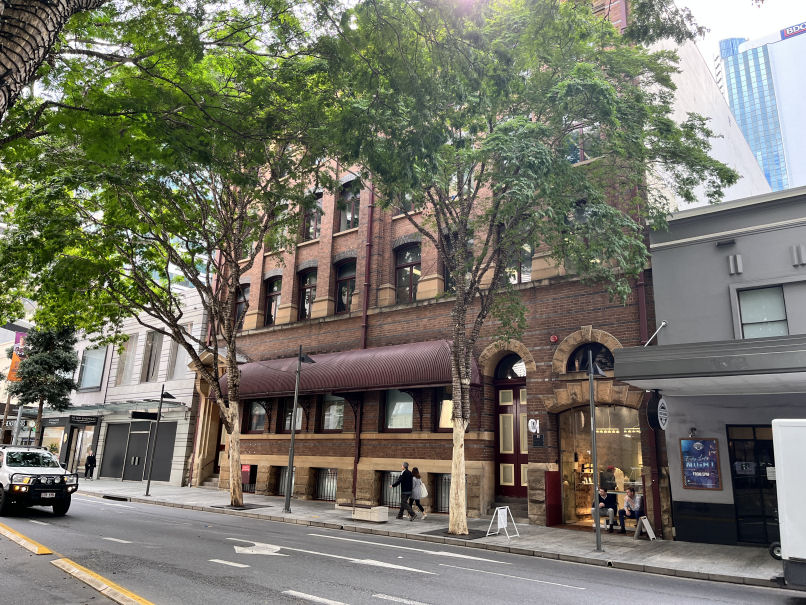61ST MACHINE RECORDS UNIT
ADJUTANT GENERALS OFFICE, US ARMY
IN AUSTRALIA DURING WWII
![]()
The 61st Machine Records Unit (US Army) was located in the Edwards Dunlop Building in Edward Street, Brisbane during WWII. This four storey building still remains and became the Catholic Centre at 143-149 Edward Street, Brisbane. Major J.W. Utterback was the Commanding Officer of the 61st Machine Records Unit.
Jerry Biscopink was a member of the 61st Machine Records Unit. In 1943 Jerry went to Camp Stoneman, USA and rode a ferry boat to Oakland and then boarded a Norwegian freighter to travel to Australia. Approximately half way across the Pacific Ocean at around midnight, their ship collided with a Liberty ship which was headed back to the USA. As a consequence they lost most of their fresh water. They called into Tonga Tabu looking for fresh water. They found none and went on to Noumea, New Caldeonia, where they obtained their much needed fresh water. Running repairs were carried out on their ship and they departed for Townsville in north Queensland. They boarded a train in Townsville in north Queensland and headed south to Brisbane.

Photo:- Peter Dunn 2 Aug 2023
Catholic Centre, Edward Street, Brisbane

Photo:- Peter Dunn 2 Aug 2023
Penola Place sign on Catholic Centre, Edward Street, Brisbane
Jerry remembers that his initial accommodation in Brisbane was at the US Camp at Luna Park, Bowen Hills. He said there was only one large building and he slept on Army cots on the dance floor. It was not a good place to sleep, as every time that someone walked across the floor, it would shake as the dance floor was well sprung. Jerry actually moved his cot out on to the verandah to achieve a better sleep.
Jerry told me that they were told not to take sun baths as it was too hot and too many GI's were getting bad burns. One Sunday morning Jerry was standing at the bottom of the hill below Luna Park waiting for a Tram to go into town when a GI passenger car pulled up and asked him if he wanted a ride into town. It was a high ranking officer. Jerry was heading into town to go to mass.
Jerry said there were very few cars on the streets of Brisbane and he recalls that some of them had a charcoal burner on the back of the car. He said that "most everyone rode on trams ... Boy, they were fast".
Jerry remembers the Botanic Gardens being located at the lower end of Edward Street on the Brisbane River. He remembers there were small kangaroos and some other animals in the park. He remembers a USO being located on Edwards Street where they would eat, read, and play table tennis.
Jerry Biscopink told me that they used International Business Machines for Punch Card Accounting on the 2nd floor of the Edwards Dunlop building. They used punch cards to store information on all US Army personnel in the Southwest Pacific Area. This information was passed on to the Signal Corps who then forwarded it back to the USA.
Records on the movements of troops were stored on IBM Punch Cards and then compiled into reports and sent back to the USA by the US Signal Corps. Jerry told me that they were told not to talk to anyone about the work that they did. Jerry found out when he returned home after the war that the US Army had carried out a background check on him with his neighbours. Jerry told me that the IBM Tabulators comprised the Key Punch, Sorter, Tabulator, and Collator.
After some time at Luna Park he relocated to Camp Yeronga where they lived in huts.
Jerry Biscopink spent 18 months in Brisbane during WWII. Jerry remembers the building that he worked in was in lower Edward Street on the same side of the road as General Douglas MacArthur's General Headquarters in the AMP building. Jerry remembers a pub down the road from where he worked. He said that beer was scarce but it was really good. He used to travel to Coolangatta on his leave. He remembers going to Lone Pine Sanctuary up the Brisbane River on a small boat where there was a zoo. He recalls holding a Koala Bear.
Jerry Biscopink's friend was Jim Bartell who was an enlisted man, but who later became an officer. When they were in Japan, Jerry was ready to go home. Jim Bartell wanted Jerry to stay for an extra six months and promised him some fast promotions. Jerry was keen to go home and knocked back Jim's offer. Jerry was due to get married in the USA 30 days later so was keen to go home.
After Jerry left Brisbane, he flew to Hollandia, Dutch New Guinea where they had a camp on Mt. Centenia. After some time they sailed on a Banana Boat (Reefer) to Manila in the Philippine Islands. There they stayed at a place called Rizal Stadium. Their equipment was installed under the stadium and they slept in pyramid tents on the in-field.
At this stage Jerry volunteered to be transferred to a mobile unit. He eventually transferred to the 1st Machine Records Unit.
Later on he travelled in an LST in a convoy, eventually landing in Yokohama, Japan. He was eventually rotated back to the USA. Jerry Biscopink was discharged from the US Army on 26 December 1945.
ACKNOWLEDGEMENTS
I'd like to thank Jerry Biscopink of Owensboro, KY for his assistance with this web page.
Can anyone help me with more information?
"Australia @ War" WWII Research Products
|
© Peter Dunn 2015 |
Please
e-mail me |
This page first produced 20 February 2009
This page last updated 05 August 2023